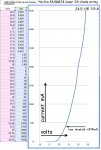Re:
Nichia NUBM34 115W 455nm
Voltage vs current graph:
This is rather elementary, but so am I.
I have to extra careful to avoid blowing stuff up; direct current only.
Having no current
/ voltage graph for the NUBM34, I decided to make one.
A couple of areas have wiggly artifacts, due to necessary wiring and heatsink changes.
As such, I do not warrant perfect accuracy but it is probably good enough to give an idea what to expect.
I only tested 1/4 of the device, one row, so that it would not get too dam hot.

As it was, 86 watts was delivered by the power supply, operating in the vicinity of rated output, for
one row of diodes.
With all rows operating, the NUBM34 will generate on the order of 250 Watts of heat. It's maximum allowable temperature is 75º celsius.
A 2" x 2" heatsink would be insufficient, in the extreme.
Preparing to connect the NUBM34 to the power supply, I first set the supply to 17 volts, current limit 50mA.
Turning on the power supply and setting the voltage and current before connecting the laser helps avoid damaging stuff.
When connected, the diodes will light, the intensity will be safe and far below lasing, which requires about 430 mA.
The voltages you find may be different, but pretty close.
p.s. As is probably obvious, this device can be wired for 25v, 50v, or 100v power supply.
- - - The supply MUST have current limiting capability in any case.
Be careful, avoid incinerating anything unintentionally.







 CDBeam
CDBeam











